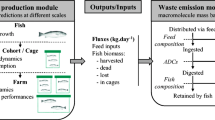Abstract
The technical and economical feasibility of farmingLaminaria saccharina for a food base product near a salmon sea cage farm was evaluated. Suitability of kelp for nutrient removal was also analyzed. A computer model of a conceptualized system was developed in order to make the assessments. Kelp growth was modelled as a linear function of temperature and background dissolved inorganic nitrogen concentration, and it was partially experimentally validated. Based on model simulations, aLaminaria farm containing 10,60 m ropes on each end of a salmon sea cage farm is fertilized by the salmon farm and yields annually 1600 kg of dried kelp. The payback period for the initial investment of $61 × 103 is 6 years after which an annual net profit of 20 × 103 Canadian dollars ($16.68 × 103 US) can be achieved. The net present worth of the kelp farm was positive for a rate of return up to 25%. Kelp production on multiple salmon farms or at a higher kelp density could increase the overall revenue.
The kelp farm does not appreciably affect background nutrient or oxygen levels. With a few modifications in the model,Nereocystis andMacrocystis farming can be substituted and evaluated for feasibility and nutrient removal efficiency.
Similar content being viewed by others
References
Ackefors H, Enell M (1990) Discharge of nutrients from Swedish fish farming to adjacent sea areas. Ambio 19: 28–35.
Anonymous (1992) Industry Price Indexes 62-011. Statistics Canada, January.
Asare S, Harlin MM (1983) Seasonal fluctuations in tissue nitrogen for five species of perennial macroalgae in Rhode Island Sound. J. Phycol. 19: 254–257.
Austreng E, Storebakken T, Äsgärd T (1987) Growth rate estimates for cultured Atlantic salmon and rainbow trout. Aquaculture 60: 157–160.
Black E, Carswell B (1987) Sechelt Inlet, Spring 1986, Impact of salmon farming on marine water quality (Draft Manuscript). British Columbia Ministry of Agriculture and Fisheries, Commercial Fisheries Branch. Victoria, British Columbia. 43 pp.
Bolton JJ, Lüning K (1982) Optimal growth and maximal survival temperatures of AtlanticLaminaria species in culture. Mar. Biol. 66: 89–94.
Carrington E (1990) Drag and dislodgment of an intertidal macroalga. J. exp. Mar. Biol. Ecol. 139: 185–200.
Chapman ARO, Marklam JW, Luning K (1978) Effect of nitrate concentration on the growth and physiology ofLaminaria saccharina in culture. J. Phycol. 4: 195–198.
Csavas I (1990) New developments in Asian aquaculture, Aquaculture International Congress Proceedings, Vancouver, British Columbia, pp. 11–35.
Druehl LD (1988) Cultivated edible kelp, In: Lembi CA, Waaland JR (eds), Algae and Human Affairs. Cambridge University Press, London, 119–134.
Druehl LD, Baird R, Lindwall A, Lloyd KE, Pakula S (1988) Longline cultivation of some Laminariaceae in British Columbia, Canada. Aquacult. Fish. Manag. 19: 253–261.
Druehl LD (1980) ‘The Development of an Edible Kelp Culture Technology for British Columbia’, II: second annual report. Province of British Columbia, Ministry of Environment, Marine Resources Branch, Victoria, B.C.
FAO (1990) Aquaculture production (1985–1988), FAO Fisheries Circular No. 815, Revision 2. Rome, Italy.
Fivelstad S, Thomassen JM, Smith JS, Kjartansson H, Sando A (1990) Metabolite production rates from Atlantic salmon and Arctic char reared in single pass land-based brackish water and sea-water systems. Aquacult. Eng. 9: 1–21.
Gerard VA (1988) Ecotypic differentiation in light-related traits of the kelpLaminaria saccharina. Mar. Biol. 97: 25–36.
Harrison PJ, Druehl LD (1982) Nutrient uptake and growth in the Laminariales and other macrophytes: a consideration of methods. In: Srivastava LM (ed.), Synthetic and Degradative Process in Marine Macrophytes. Walter de Gruyter, New York, 99–120.
Harrison PJ, Druehl LD, Lloyd KA, Thompson PA (1986) Nitrogen uptake kinetics in three year classes ofLaminaria groenlandica. Mar. Biol. 93: 29–35.
Inoue H (1972) An extended summary of a Japanese paper on water exchange in a net cage stocked with fish. Bull. Jap. Soc. Sci. Fish. 38: 167–176.
Jackson GA, Winant CD (1983) Effect of a kelp forest on coastal currents. Cont. Shelf Res. 2: 75–80.
Korman J (1989) Enriching Effects of Salmon Farms in British Columbian Waters and the Influence of Flushing and Seasonality. M.Sc. Thesis, University of British Columbia. 94 pp.
Liao PB, Mayo RD (1974) Intensified fish culture combining water reconditioning with pollution abatement. Aquaculture 3: 61–85.
Mazhari K (1992) Technical and Economical Feasibility of Integrated Salmon and Kelp Production System. M.Sc. Thesis, University of British Columbia. 111 pp.
Parson TR, Takahashi M, Hargrave B (1984) Biological Oceanographic Processes. 3rd Edition, Pergamon Press, Oxford, 69–71.
Subandar A (1991) Nitrogen Uptake and Growth Rate of Kelp (Laminaria saccharina) Grown in an Outdoor Culture System Using Salmon Culture Effluent. M.Sc. Thesis, University of British Columbia, 63 pp.
Tseng CK (1981) Commercial cultivation. In: Lobban CS, Wynne MJ (eds), The Biology of Seaweeds. Blackwell Scientific, New York, 680–687.
Weston PD, (1986) The Environmental Effects of Floating Mariculture in Puget Sound. Wash. Dept. Fish. and Wash. Dept. Ecol. 148 pp.
Author information
Authors and Affiliations
Rights and permissions
About this article
Cite this article
Petrell, R.J., Tabrizi, K.M., Harrison, P.J. et al. Mathematical model ofLaminaria production near a British Columbian salmon sea cage farm. J Appl Phycol 5, 1–14 (1993). https://doi.org/10.1007/BF02182416
Received:
Revised:
Accepted:
Issue Date:
DOI: https://doi.org/10.1007/BF02182416




